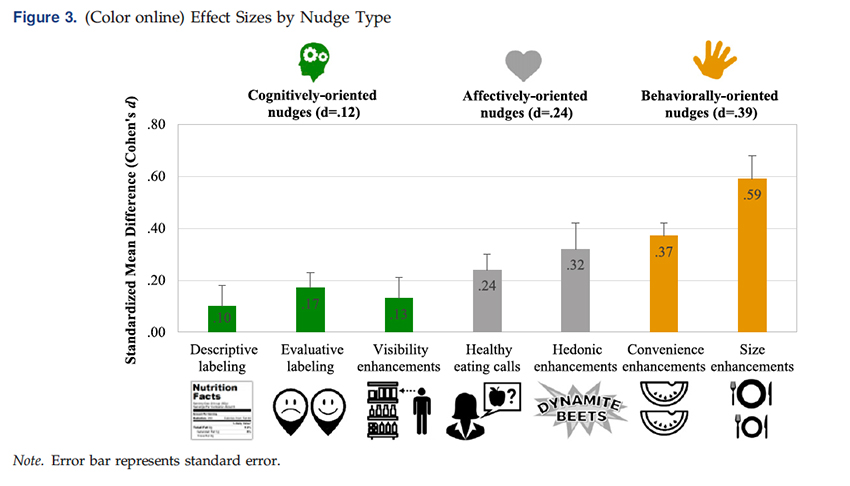Blog by Chuck Dinerstein: “Policymakers love nudges – predictably altering people’s behavior without forbidding choices or changing economic incentives. That is especially true for our food choices since we all eat, and it is clear that diet does have some effect on our health. The “promise to improve people’s diet at a fraction of the cost of economic incentives or education programs without imposing new taxes or constraints on business or consumers,” is a have my cake and eat it world. A study by the masters of understanding our behavior, the marketers, sheds light on which nudges work best….
Cognitive nudges include those often-invoked nutritional labels or evaluative labels that skip the verbiage and are green for buy, red for put it back on the shelf, and yellow for it’s up to you. Visibility enhancements refer to getting the item into your visual field at the right time and place, like eye-level on the shelf or in the check-out line. Nudges that appeal to our feelings include all the images making food appealing, think food porn, or simple slogans, e.g., “natural,” “healthy choice,” or ”just like mama made.” (Assuming mom was a good cook). As the researchers point out, there are no labels on foods that promote guilt or concern as we see on tobacco’s Surgeon General warnings. Finally, there are behavioral nudges that make one choice easier than another, precut fruits and vegetables, or big utensils for vegetables, and tiny ones for fried chicken. It also includes smaller plates that might look fuller or large drink glasses that are 80% ice
Here is the graphic of their findings:

Graphic by Pierre Chandon
- Nudges do move behavior, although the effect is small, a change of about 124 calories, or in the author’s words “eight fewer teaspoons of sugar.” For those who do not eat sugar by the spoonful, you might consider this to be 1 ½ Jelly Filled Munchkins.
- As the graph shows, appealing to our intellect works the least well, appeals to our emotions are twice as effective, and making it easy to do the “right thing” works the best, five-fold better, than educating us.
- Nudges are better at decreasing bad choices than increasing good ones. “it is easier to make people eat less chocolate cake than to make them eat more vegetables…” In fact, total eating was basically unaffected by nudges, again as the authors write, “this finding is consistent with what we know about the difficulty – perhaps even pointlessness – of hypocaloric diets.”
- The effect of nudges is a lot less when you’re shopping than when you’re eating.
- The effect of nudges in isolation seems more pronounced statistically speaking than when considered in conjunction with where they take place and other contextual information.
- Nudges were equally effective, or ineffective, with adults and children; although you might expect that adults would be more responsive given their presumably better understanding of diet and health
The study makes two points. First, nudges can move behavior a little bit, and the fact that it has few recognized costs means that policymakers will continue to utilize them. Second, it provides an analytic framework highlighting areas where the evidence is scant and could, I suggest, nudge researchers to explore….(More)”.